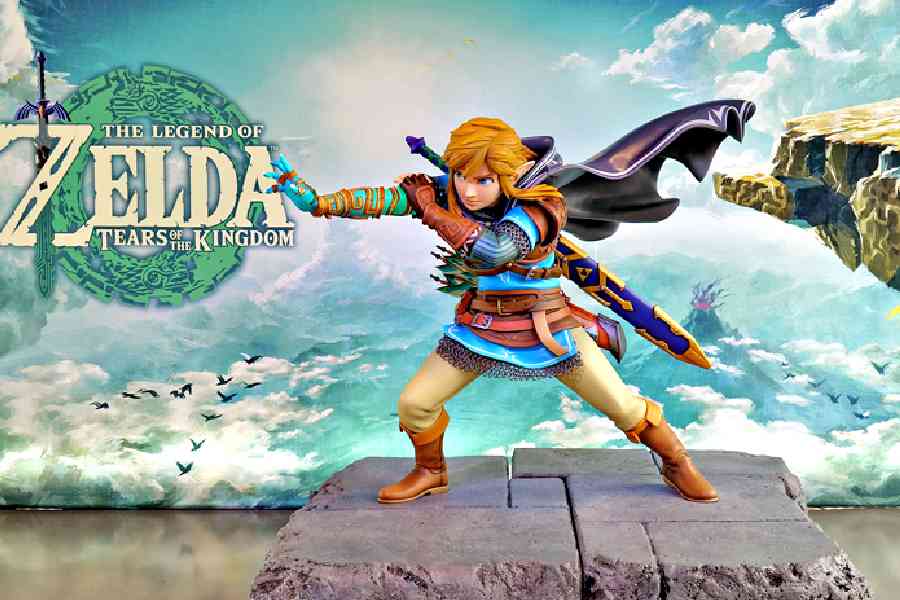The footage was only two minutes long, yet that was enough to conjure months of debate over sacred relics, goddesses and swords that could easily be confused for the arcane squabbles of medievalists studying Arthurian legend.
The experts were discussing a more recent hero’s tale, one that has unfolded over the past four decades in a doomed kingdom called Hyrule. Over 6 million people watched the preview for hints about the next video game in Nintendo’s beloved Legend of Zelda franchise.
It has been six years since the last entry Breath of the Wild revitalised the series with the apotheosis of an open-world game, one that tantalised players to explore a vibrant environment full of ambitious quests.
Tears of the Kingdom, released on May 12, opens that world further, with sky islands and caves. The game also gives Link, its protagonist, new abilities that allow him to construct vehicles and weapons by combining an array of items in a system that rewards ingenuity.
The immersive gameplay of the Zelda franchise is bolstered by its deep mythology, convincing players they are unearthing ancient secrets.
“Someone might write an entire university dissertation on a specific part of the worlds created by Tolkien,” said Ed King, a British gamer who translates the mysteries of the Zelda universe for his 7,00,000 YouTube subscribers. “Zelda lore isn’t quite on that level yet, but it does have depth.”
The video game franchise that started in 1986 with a pixelated map guarded by ghosts and goblins has evolved into an elaborate topography of mountain ridges, coastline villages and enemy hideouts. The gameplay has also become more riveting, with puzzle-box designs and environmental storytelling.
The original Legend of Zelda was the brainchild of Shigeru Miyamoto, who has described Hyrule as “a miniature garden that you can put into a drawer and revisit anytime you like.”
But over the past 20 years, the stories have become more nuanced, with a tone and artistic style displaying the influence of Japanese animator Hayao Miyazaki. Link has sailed across the sea, lived above the clouds, transformed into a wolf and even become a train conductor. He has forged the ancient blade of evil’s bane and shrunken down to microscopic size.
Another series producer, Eiji Aonuma, has been responsible for scattering the narrative breadcrumbs that elevate the Zelda games. In the late 1990s, Aonuma began working on the Zelda series as a dungeon designer for Ocarina of Time, a Nintendo 64 game that was the franchise’s first adventure with 3D graphics. Those dungeons illustrated Aonuma’s penchant for mixing narrative and gameplay. His puzzles were not just a series of rooms, but haunted mansions, secret shrines and the innards of a giant fish.
Later Zelda games, like the Twilight Princess, a launch title for the Nintendo Wii, would return to the formula established in Ocarina of Time, with a gameplay loop of clearing dungeons and traversing the overworld with grappling hooks, boomerangs and bombs.
Nintendo had succeeded in recapturing the original Legend of Zelda game’s joy of exploration, giving Link the new abilities to freely jump and climb walls. Although he remained silent, other characters had fully voiced dialogue for the first time. Traditional dungeons were replaced by puzzles hidden inside four divine beasts and 120 shrines, and 900 scattered Korok seeds gave Link incentive to search the landscape.
The feeling of wonder in Breath of the Wild emerged from a design philosophy that the director, Hidemaro Fujibayashi, called “multiplicative gameplay”.
Multiplicative gameplay encourages players to combine actions and objects in ways that allow for a vaster set of solutions. Developers created a prototype to test their theories, recreating the original Legend of Zelda game with an interactive environment where the player could burn trees, pick up the logs and then make rafts from the timber. Players can feel a dynamic world where bolts of lightning might trigger brush fires that roast the apples on a nearby tree, and the game also encourages new combinations of weapons and objects.
“The word Zonai is based on an anagram in Japanese for the word ‘mystery,’ and it was deliberately added to give a sense that something might have come before you,” King explained. “If everything is strictly relevant to the plot, you would have the sense that the game world is fake. But evidence of the Zonai makes you feel like it all could be real.”
NYTNS










